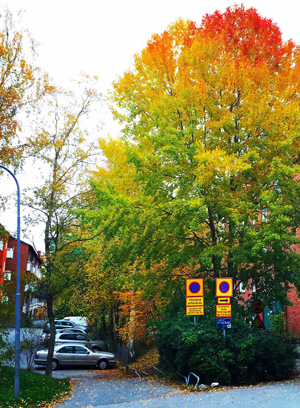Hedges in towns and cities.

Hedges originally served the function of corralling animals; however they also offer habitats for many plant and animal species and they serve as important ecological corridors. Now another role for hedges has been suggested - that of combating air pollution in our towns and cities.
Urban air pollution has been linked to
- Respiratory illness and infections : pollution in the form of minute particulates, and nitrogen & sulphur oxides is thought to exacerbate a number of conditions from asthma to COPD [chronic obstructive pulmonary disease].
- Heart disease : very small particles of pollutants have the potential to bypass the lungs' protective filters, penetrating deep into the body - building up in the blood vessels raising the risk of heart disease.
- Damage to the central nervous system - there is now evidence that minute particles of magnetite (a form of iron oxide), which can be derived from vehicle engines and braking systems, can find their way into the brain.
- Damage to the genetic material - recent research has indicated that traffic related air pollution (PAHs -polycyclic aromatic hydrocarbons) can cause damage to the genetic material (DNA) in the form of telomere shortening. This form of DNA damage is associated with ageing.
 Professor Prashant Kumar (University of Surrey) and his colleagues have suggested that in some circumstances hedges are better than trees in taking up some of the air pollution associated with our roads / traffic in the urban environment. The role of trees / leaves in helping reduce air pollution has featured in a recent blog - but as was mentioned, the way in which trees are planted in an urban setting needs to be considered.
Professor Prashant Kumar (University of Surrey) and his colleagues have suggested that in some circumstances hedges are better than trees in taking up some of the air pollution associated with our roads / traffic in the urban environment. The role of trees / leaves in helping reduce air pollution has featured in a recent blog - but as was mentioned, the way in which trees are planted in an urban setting needs to be considered.
A city street with a heavy flow of traffic and surrounded by high rise buildings can become a ‘street canyon’ in which pollutants are trapped and the level of air pollution rises. If trees were to form a dense canopy over a street, then the same effect could be created.
However, hedges / hedgerow plants can trap pollutants and they are ‘down at tailpipe / exhaust pipe level’. A hedge can slow down the flow of air and the pollutants get caught on the leaves - as is evidenced by the dust and dirt seen on trimming back at privet hedge. Professor Kumar and his co-workers are hoping to determine the most effective plants to use in urban hedges and the most effective height of such hedges.
Professor Kumar, who is Chair in Air Quality & Health has said that “future urban planning need to consider designing and implementing more ‘green infrastructure’, such as trees or hedges in the built environment to create a more healthy urban lifestyle”.
Update from the web :
“An extensive field study into air quality along a road lined with buildings has confirmed that hedges can help mitigate traffic-related pollution up to 1.7m, reducing the pollutants breathed by pedestrians, young children and cyclists.”
https://www.sciencedaily.com/releases/2021/10/211014131222.htm
Comments are closed for this post.

I have a Ninety year old mainly privet hedge at the bottom of my garden, Which I have maintained for the last Sixty five years and it really needs layering as it is now seven – eight feet high .
There is some Holly and Beech also in it and I have removed two dead privet from it. Would it be better to cut wedges in the down side or remove larger lengths from the up side. It has grown at the edge of my land in the earth covered of brick scrap and rubble probably left by the builders ninety years ago.
I shan’t do any thing till mid-September, thank you for any advice.
Malcolm
Malcolm. Torry BEM
26 August, 2021